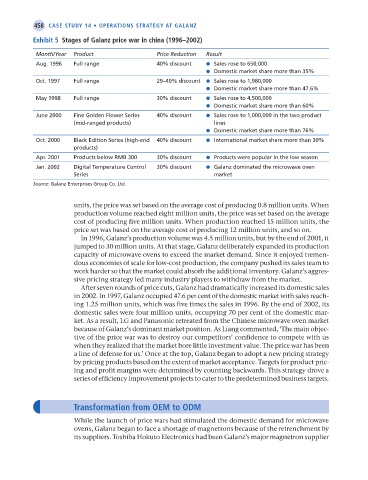Page 483 - Operations Strategy
P. 483
458 case study 14 • OperatiOns strategy at galanz
exhibit 5 stages of galanz price war in china (1996–2002)
Month/Year Product Price Reduction Result
Aug. 1996 Full range 40% discount ● Sales rose to 650,000
● Domestic market share more than 35%
Oct. 1997 Full range 29–40% discount ● Sales rose to 1,980,000
● Domestic market share more than 47.6%
May 1998 Full range 30% discount ● Sales rose to 4,500,000
● Domestic market share more than 60%
June 2000 Fine Golden Flower Series 40% discount ● Sales rose to 1,000,000 in the two product
(mid-ranged products) lines
● Domestic market share more than 76%
Oct. 2000 Black Edition Series (high-end 40% discount ● International market share more than 30%
products)
Apr. 2001 Products below RMB 300 30% discount ● Products were popular in the low season
Jan. 2002 Digital Temperature Control 30% discount ● Galanz dominated the microwave oven
Series market
Source: Galanz Enterprises Group Co. Ltd.
units, the price was set based on the average cost of producing 0.8 million units. When
production volume reached eight million units, the price was set based on the average
cost of producing five million units. When production reached 15 million units, the
price set was based on the average cost of producing 12 million units, and so on.
In 1996, Galanz’s production volume was 4.5 million units, but by the end of 2001, it
jumped to 30 million units. At that stage, Galanz deliberately expanded its production
capacity of microwave ovens to exceed the market demand. Since it enjoyed tremen-
dous economies of scale for low-cost production, the company pushed its sales team to
work harder so that the market could absorb the additional inventory. Galanz’s aggres-
sive pricing strategy led many industry players to withdraw from the market.
After seven rounds of price cuts, Galanz had dramatically increased its domestic sales
in 2002. In 1997, Galanz occupied 47.6 per cent of the domestic market with sales reach-
ing 1.25 million units, which was five times the sales in 1996. By the end of 2002, its
domestic sales were four million units, occupying 70 per cent of the domestic mar-
ket. As a result, LG and Panasonic retreated from the Chinese microwave oven market
because of Galanz’s dominant market position. As Liang commented, ‘The main objec-
tive of the price war was to destroy our competitors’ confidence to compete with us
when they realized that the market bore little investment value. The price war has been
a line of defense for us.’ Once at the top, Galanz began to adopt a new pricing strategy
by pricing products based on the extent of market acceptance. Targets for product pric-
ing and profit margins were determined by counting backwards. This strategy drove a
series of efficiency improvement projects to cater to the predetermined business targets.
transformation from OeM to OdM
While the launch of price wars had stimulated the domestic demand for microwave
ovens, Galanz began to face a shortage of magnetrons because of the retrenchment by
its suppliers. Toshiba Hokuto Electronics had been Galanz’s major magnetron supplier
Z14 Operations Strategy 62492.indd 458 02/03/2017 13:59

